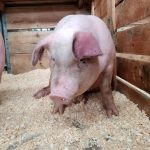Hawks are predatory birds renowned for their exceptional vision and efficient hunting skills. They are typically drawn to areas with plentiful prey, such as open fields and farms where chickens and other small animals reside. As diurnal hunters, hawks are most active during daylight hours, utilizing their acute eyesight to identify potential prey from elevated positions.
Their remarkable speed and aerial agility enable them to swiftly descend and capture targets with great accuracy. To effectively safeguard chickens from hawk attacks, it is crucial to comprehend these birds’ behavior. Hawks are opportunistic predators that will target any accessible small animals.
They are also territorial, defending their hunting grounds from other predators and rivals. By understanding these characteristics, chicken owners can implement proactive measures to deter hawks and protect their flocks. Hawks are known for their adaptability and intelligence, which makes them formidable hunters.
They can learn and modify their hunting techniques based on their surroundings and prey behavior. Consequently, chicken owners must remain vigilant and actively employ deterrents to keep hawks away. A thorough understanding of hawk behavior allows chicken owners to anticipate and prevent potential attacks, thereby ensuring the safety and well-being of their flock.
Table of Contents
- 1 Implementing physical barriers to protect chickens
- 2 Using scare tactics to deter hawks
- 3 Providing alternative food sources for hawks
- 4 Creating a safe and secure chicken coop
- 5 Using decoys and visual deterrents
- 6 Seeking professional assistance if necessary
- 7 FAQs
- 7.1 What are some effective methods for keeping hawks from killing chickens?
- 7.2 Are there any natural deterrents for hawks?
- 7.3 What are some signs that a hawk is targeting my chickens?
- 7.4 Is it legal to harm or kill hawks to protect my chickens?
- 7.5 How can I protect my chickens from hawks without harming the hawks?
Key Takeaways
- Hawks are opportunistic predators and will target chickens as easy prey
- Physical barriers such as fences, netting, and covers can effectively protect chickens from hawk attacks
- Scare tactics like noise makers, reflective objects, and predator decoys can help deter hawks from targeting chickens
- Providing alternative food sources such as bird feeders and small animal habitats can reduce the likelihood of hawks preying on chickens
- A secure chicken coop with sturdy walls, doors, and locks is essential for protecting chickens from hawk attacks
- Decoys and visual deterrents like fake predators and shiny objects can help keep hawks away from chicken areas
- Seeking professional assistance from wildlife experts or pest control services can be necessary for dealing with persistent hawk threats
Implementing physical barriers to protect chickens
Implementing Physical Barriers
One effective way to safeguard chickens from hawk attacks is by installing physical barriers around the chicken coop and run. This can include setting up a sturdy fence or netting that is tall enough to prevent hawks from swooping down and capturing the chickens. The barrier should also be buried into the ground to prevent hawks from digging underneath it.
Additional Protection Measures
Covering the top of the chicken run with netting or wire mesh can provide extra protection from aerial attacks. Another physical barrier that can be effective in deterring hawks is the use of scare tape or reflective materials. These can be hung around the perimeter of the chicken coop and run to create a visual deterrent for hawks. The reflective surfaces will disorient and confuse the hawks, making it more difficult for them to accurately target the chickens.
Securing the Chicken Coop
It is also crucial to ensure that the chicken coop itself is secure and predator-proof. This means using sturdy materials for construction, such as heavy-duty wire mesh or hardware cloth, to prevent hawks from gaining access to the chickens. Additionally, reinforcing doors and windows with locks or latches can further protect the chickens from potential attacks. By implementing physical barriers and securing the chicken coop, chicken owners can effectively deter hawks and keep their flock safe from harm.
Using scare tactics to deter hawks

In addition to physical barriers, scare tactics can be an effective method for deterring hawks from targeting chickens. One common scare tactic is the use of predator decoys, such as owl or hawk decoys, which can be placed around the chicken coop and run to create the illusion of a larger predator in the area. This can intimidate hawks and discourage them from approaching the chickens.
It is important to regularly move the decoys around to prevent hawks from becoming accustomed to their presence. Another effective scare tactic is the use of noise deterrents, such as motion-activated alarms or radios. These devices can emit loud noises or sounds that are unfamiliar to hawks, causing them to become startled and fly away from the area.
Additionally, hanging wind chimes or other noise-making objects around the chicken coop can create a constant source of sound that can deter hawks from approaching. Visual deterrents, such as scarecrows or brightly colored flags, can also be effective in deterring hawks. These objects create movement and visual disturbances that can make hawks feel uneasy about approaching the area.
By using a combination of scare tactics, chicken owners can effectively deter hawks from targeting their flock and create a safer environment for their chickens.
Providing alternative food sources for hawks
One way to deter hawks from targeting chickens is by providing alternative food sources that can satisfy their hunting instincts. This can include setting up bird feeders or offering small amounts of food, such as mice or insects, in a designated area away from the chicken coop. By providing these alternative food sources, chicken owners can help redirect the attention of hawks away from their flock and reduce the likelihood of attacks.
Another method for providing alternative food sources for hawks is by creating a habitat that attracts natural prey, such as rodents or small birds. This can include planting shrubs or trees that provide cover for small animals, as well as creating a water source that can attract insects and other prey for hawks to feed on. By creating a diverse and abundant habitat, chicken owners can help ensure that hawks have access to natural food sources without targeting their chickens.
It is important to note that providing alternative food sources for hawks should be done in a way that does not compromise the safety of other animals or disrupt the natural balance of the ecosystem. By carefully managing alternative food sources, chicken owners can help deter hawks from targeting their flock while also supporting the natural behaviors and needs of these predatory birds.
Creating a safe and secure chicken coop
Creating a safe and secure chicken coop is essential for protecting chickens from hawk attacks. This includes using sturdy materials for construction, such as heavy-duty wire mesh or hardware cloth, to prevent hawks from gaining access to the chickens. Additionally, reinforcing doors and windows with locks or latches can further protect the chickens from potential attacks.
It is also important to regularly inspect the coop for any signs of wear or damage and make necessary repairs to ensure its integrity. In addition to securing the physical structure of the coop, it is important to consider the layout and design of the surrounding area. This includes ensuring that there is adequate cover for the chickens to seek refuge in case of an attack, such as shrubs or trees that provide shelter from aerial predators.
Creating a secure outdoor run with a covered top can also provide additional protection for the chickens while allowing them access to fresh air and sunlight. Another important aspect of creating a safe and secure chicken coop is implementing proper management practices, such as regularly cleaning and maintaining the coop to reduce potential attractants for hawks, such as food scraps or waste. By creating a clean and well-maintained environment for the chickens, chicken owners can help reduce the likelihood of hawk attacks and ensure the overall health and well-being of their flock.
Using decoys and visual deterrents

Decoys: A Hawk’s Worst Nightmare
In addition to physical barriers, decoys and visual deterrents can be effective in deterring hawks from targeting chickens. One common decoy used for this purpose is an owl decoy, which can be placed in strategic locations around the chicken coop and run to create the illusion of a larger predator in the area. This can intimidate hawks and discourage them from approaching the chickens.
Movement and Visual Disturbances
It is important to regularly move the decoys around to prevent hawks from becoming accustomed to their presence. Visual deterrents, such as scarecrows or brightly colored flags, can also be effective in deterring hawks. These objects create movement and visual disturbances that can make hawks feel uneasy about approaching the area.
Noise and Reflection: A One-Two Punch
Additionally, hanging wind chimes or other noise-making objects around the chicken coop can create a constant source of sound that can deter hawks from approaching. Another visual deterrent that can be effective in deterring hawks is the use of reflective materials or scare tape. These can be hung around the perimeter of the chicken coop and run to create a visual deterrent for hawks. The reflective surfaces will disorient and confuse the hawks, making it more difficult for them to accurately target the chickens.
Seeking professional assistance if necessary
If despite all efforts hawk attacks continue to pose a threat to your chickens, it may be necessary to seek professional assistance. Wildlife experts or bird control specialists may be able to provide valuable insight into effective deterrent methods specific to your location and situation. They may also be able to offer advice on legal methods for dealing with predatory birds in your area.
In some cases, obtaining permits for non-lethal control methods may be necessary if hawk attacks persist despite all efforts at deterrence. It’s important to consult with local wildlife authorities before taking any action against predatory birds in order to ensure compliance with regulations. Professional assistance may also be necessary if you suspect that a hawk has become injured or trapped on your property due to your deterrent measures.
In such cases, it’s important to contact wildlife rescue organizations or animal control services for assistance in safely removing or rehabilitating the bird. In conclusion, protecting chickens from hawk attacks requires a multi-faceted approach that takes into account both the behavior of hawks and effective deterrent methods. By understanding hawk behavior, implementing physical barriers, using scare tactics, providing alternative food sources, creating a safe chicken coop environment, using decoys and visual deterrents, and seeking professional assistance if necessary, chicken owners can effectively protect their flock from potential harm while supporting healthy ecosystems and wildlife conservation efforts.
If you’re looking for ways to protect your chickens from predators like hawks, you may also be interested in learning about whether guinea fowl can live with chickens. Check out this article on poultrywizard.com to find out more about keeping guinea fowl and chickens together and how they can help protect each other from predators.
FAQs
What are some effective methods for keeping hawks from killing chickens?
Some effective methods for keeping hawks from killing chickens include using netting or wire mesh to cover the chicken coop, installing scare devices such as reflective tape or predator decoys, and providing overhead cover for the chickens to hide under.
Are there any natural deterrents for hawks?
Yes, some natural deterrents for hawks include planting tall trees or shrubs around the chicken coop to provide cover for the chickens, and allowing roosters to protect the flock by alerting them to the presence of hawks.
What are some signs that a hawk is targeting my chickens?
Some signs that a hawk is targeting your chickens include seeing a hawk circling overhead, finding feathers or remains of chickens in the yard, or observing a hawk repeatedly visiting the area where the chickens are kept.
Is it legal to harm or kill hawks to protect my chickens?
No, it is illegal to harm or kill hawks as they are protected under the Migratory Bird Treaty Act. However, there are legal methods for deterring hawks from targeting chickens, such as using scare devices or providing cover for the chickens.
How can I protect my chickens from hawks without harming the hawks?
You can protect your chickens from hawks without harming the hawks by using non-lethal deterrents such as netting, scare devices, and providing natural cover for the chickens to hide under. It is important to use legal and humane methods to protect your chickens from predators.
Meet Walter, the feathered-friend fanatic of Florida! Nestled in the sunshine state, Walter struts through life with his feathered companions, clucking his way to happiness. With a coop that’s fancier than a five-star hotel, he’s the Don Juan of the chicken world. When he’s not teaching his hens to do the cha-cha, you’ll find him in a heated debate with his prized rooster, Sir Clucks-a-Lot. Walter’s poultry passion is no yolk; he’s the sunny-side-up guy you never knew you needed in your flock of friends!







